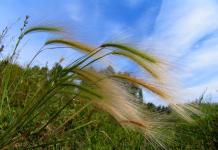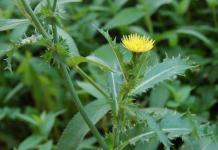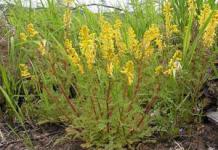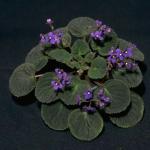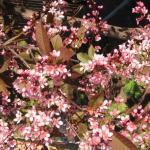Family Bradybene Bradybaenidae
In land snails, the shell is spirally twisted. In some species, the shell is elongated, so that its height noticeably exceeds its width; in other species, on the contrary, the shell is low and its width is greater than its height. During movement, the mollusk protrudes its head and leg from the shell.
There are 4 tentacles directed forward on the head. At the ends of two longer tentacles there are dark balls - these are the eyes. If you gently touch the tentacles, the mollusk immediately draws them in, and if it is strongly disturbed, it will completely hide in the shell. In Russia and the CIS countries, there are several hundred species of snails. Basically, these are very small species that are difficult to distinguish from each other (often only by their internal structure).
bush snail










Bush snail video
Bush snail ( Fruticicola (Bradybaena) fruticum) - a type of pulmonary earth snails.
The shell is large and round, its size is from 13 to 25 mm. Turns 5-6.5. The mouth is round or elliptical. The color of the shell varies from gray-white, greenish-yellow to red-brown, and even blue-black. The mantle is grey-white to yellowish, sometimes speckled.
The species is distributed in Central and Eastern Europe, Western Asia. Absent from the British Isles, western France, Scandinavia and southern Europe. It lives on the edges of the forest, in light forests, in wet meadows and fields. Forage plants: nettle ( Urtica spp.), hops ( Humulus spp.) and other herbaceous plants. Since September it feeds on detritus. Depending on the ambient temperature in October or November, the species hibernates under foliage or on the ground. The mouth of the shell is closed with a calcareous membrane.
Snails become sexually mature at the age of 13-14 months and begin to mate. The shell reaches the size of an adult in 15-22 weeks. Egg laying occurs only in the third year, usually in May or June. Snails lay 10-70 eggs several times in small depressions in the ground. Spherical eggs are white, 2.5-3 mm in diameter. Development depends on the ambient temperature and lasts from 26 to 50 days. Snails appear with a shell size of 2 to 2.5 mm and 1.5 coils. Life expectancy in captivity is 6.5 years.
The shell of this snail is spherical, almost smooth, 16-17 mm high, 18-20 mm wide, with 5-6 whorls. The color varies from grayish-white to reddish-horn, often a narrow brown band is visible on the last whorl of the shell.
It lives in shrubs, deciduous forests, gardens, often the bush snail can be found on nettles and coltsfoot. Sometimes it climbs quite high on bushes, tree trunks and fences.
Distributed in the European part of Russia, in the Crimea and the North Caucasus. The only representative in the forest zone of the South Asian bradyben family (Bradybaenidae). This species is regarded as a relic of an ancient heat-loving fauna, which was common in the Tertiary time on the territory of modern Siberia and Northern Europe.
It feeds on green vegetation (nettle, hops). It hibernates under leaves or burrows into the soil, tightly clogged with a calcareous membrane. Dry summer periods are also experienced in diapause.
A snail is a unique living creature that is protected by a shell and can live not only in the wild, but also at home. This species of animal belongs to the class of gastropods (gastropods), the type of molluscs. The word snail comes from the Old Slavonic "snail" - hollow because of its house (shell), which is empty without an animal.
Snail - description and characteristics
The body of a snail consists of a head, a leg, an visceral sac, and a mantle fold. The movement of the mollusk occurs on the sole, which covers the lower part of the leg. This process is the result of muscle contractions that create a kind of wave. To make sliding as comfortable as possible, the epithelium of the limb secretes a lot of mucus.
Snails of small size can move with the help of the beating of cilia.
The visceral sac is located inside the shell in the form of a spiral or cap. In the mantle of snails that live in water, gills are located. This body must be constantly washed by a stream of water, in order to organize this process, the mantle is equipped with:
- inlet siphon through which the liquid enters;
- outlet siphon through which water is removed.
Also inside the mantle are:
- kidney ducts;
- excretory system;
- intestines;
- sexual apparatus;
- lung (for those living on land).
In order for air to enter the respiratory organs, there is a special hole. It is located on the edge of the shell or on the front side of the body.
The head consists of:
- stalks with eyes;
- tentacles (organ of touch);
- oral cavity.
The shell of a snail, like other mollusks, consists of several layers:
- The periostracum is a thin layer that covers the structure from the outside. It is made up of a protein called conchiolin.
- Ostracum is a calcium carbonate middle layer wrapped in conchiolin.
- Hypostracum (mother-of-pearl) - a layer located inside. It includes plates of calcium carbonate coated with conchiolin.

The shell is an integral part of the snail's body. The external skeleton of the mollusk protects it from enemies, external negative factors, and retains moisture.
A snail is born with a shell, only in babies it is thin and transparent.
The shape of the external skeleton: conical, in which all the organs of the mollusk are located asymmetrically or flat spiral. The surface is smooth or with outgrowths. The turns in the helix are arranged from left to right, but there are very rare cases when the opposite is true. Sizes and colors may vary.
Some snails have a reduced shell - this is a calcareous plate inside the mantle. Basically, these are slugs that can be found in any garden.
Teeth
Representatives of gastropods are distinguished by a special organ in the oral cavity - the radula. This organ performs the functions of the tongue and teeth. The radula consists of a cartilaginous plate on which there are several rows of teeth of various shapes.

Vegetarian snails have small teeth, predators have large ones in the form of a pike or gaff. The number of teeth in a cochlea can reach 25,000. Basically, the radula includes 120 rows, each with 100 teeth = 12,000.
Poisonous snails mainly have teeth with a cavity through which poison flows from a special gland, paralyzing the victim.
In nature, snails live, which feed on animal food. Such species are distinguished by teeth in the form of a drill. It can drill into the oyster shell or other hard protective shells, which helps the mollusk get to the meat.
Clam mucus is a compound that is very important for the snail. It consists of a complex protein (mucin) and water.

The unique properties of this substance are widely used today in cosmetology as a rejuvenating, sunscreen, moisturizer.
Mucin regulates the processes of mineralization and shell formation. Slime is divided into two types:
- The first type helps the mollusk move by moistening the surface.
- The second type is produced by a special gland, as a response to any stress and mechanical damage to the shell. The main components of such mucus are polysaccharides, mineral salts, which have restorative, regenerating properties.
The snail lives in all climatic conditions on all continents except Antarctica and arid deserts. The mollusk lives in the warm waters of the Pacific Ocean, the Mediterranean and in the cold environment of the Arctic Ocean, the Barents Sea.

Snails feel great in Europe, Africa, Australia, America. It is found in Asia and Russia. The main condition for the existence of a mollusk is high humidity, which will not allow the body of the snail to dry out, otherwise the animal may die.
Everything that a snail eats depends on its habitat. The nutrition of the mollusk surprises with its diversity, it can be:
- soft part of fresh plants.
- plant remains;
- small relatives;
- worms;
- carrion;
- fish;
- insects;
- crustaceans.
Land mollusks are happy to eat leaves, berries, fruits, vegetables, bark, grass. The young prefer fresher food, but as they age, their preferences change, and the old snail begins to feed on rotten plants.
Some species eat flies, midges, mosquitoes, carrion. A delicacy for a street snail can be a rotten tree.

To grind food well, the teeth of the mollusk require calcium. Its deficiency leads to the fact that the snail begins to sharpen its shell, which collapses, leaving the body without protection. This leads to dehydration and death.
Snails in the aquarium can be fed:
- fish food;
- aquarium plants;
- algae tablets;
- chopped vegetables.
So that the aquarium is not left without all the vegetation, the number of mollusks is best taken under control. A moderate amount of snails is good for algae, as they eat all the rot on them and clean the aquarium. It is also recommended to grind eggshells in a coffee grinder to replenish calcium in the body of gastropods.

It is worth monitoring the nutrition of the pet, he should not be given human food. And also it is necessary to put newspapers away, because the snail eats them with great pleasure, but after such a feast it rarely survives.
You can include a diet:
- plantain;
- legumes;
- cucumbers, zucchini, pumpkin, tomatoes, bell peppers;
- greenery;
- dandelions;
- bananas, watermelon, pears, strawberries, apples.
For land representatives, do not forget to put a bowl of clean water.
Gastropods in most cases are oviparous animals. The process of fertilization and egg laying depends on the habitat of the snail.
Snails with lungs living in fresh waters and on land are hermaphrodites. Such mollusks have both female and male sexual characteristics. In this connection, during mating, fertilization occurs cross.

Freshwater snails lay their eggs in capsules, and land snails in dug holes. At a time, the mollusk is able to lay up to 85 pieces. Eggs ripen within 28 days and may have a different color:
- transparent;
- green;
- white;
- pink.
The development of this snail takes place without stages of transformation. After passing the prescribed ripening period, a formed individual with a transparent shell appears, which eventually hardens and gets its color.

Snails with gills are heterosexual creatures. Males are endowed with a testis and a vas deferens. Female mollusks have an ovary and an oviduct.
Egg laying takes place in a special cocoon with a lid that dissolves at the time of development of the larvae. For the safety of future offspring, the outer row of eggs is not filled, this allows you to leave the predator without lunch.

The development of gastropods takes place with transformations from egg to larva (veliger). With the help of outgrowths with thin cilia, it moves and feeds on small particles of food of plant and protein origin. After a few days, the mollusk forms and sinks to the bottom.
There are unique species of gill snails that do not lay eggs, but go through a gestation cycle. The fetus remains in the mother's body until it is fully mature and only then is born.
Snail diseases
Snails can suffer from the following diseases:
- Broken shell, holes, cracks. In this case, the animal should receive the maximum amount of calcium, rest, high humidity and the correct temperature.
- Shell lamination. This process can occur against the background of improper maintenance, stress, poor heredity.
- White coating on the sink. The problem arises against the background of poor conditions, as an age change or it can be a simple wear.
- Burns. They are thermal, chemical. In this case, the snail hides in the shell and hardly moves. You can alleviate the condition by increasing the humidity and increasing the amount of juicy vegetables and fruits in the diet.
- Poisoning. It happens due to poor quality food.
- Self-gnawing. The snail begins to eat itself due to calcium deficiency, stress or heredity.
- Prolapse of organs.
Enemies in the wild

Gastropods are among the most inconspicuous organisms on earth. But, despite this, the individual has enough enemies:
- sea gobies;
- sardine;
- sea stars;
- mackerel;
- whales;
- herring;
- hermit crabs.
For land snails, the danger is:
- moles;
- thrushes;
- wild boars;
- lizards;
- hedgehogs.
Freshwater clams should be afraid of:
- trout;
- storks;
- frogs;
- herons.
Snails are slow and cautious, which helps them to protect themselves from enemies. They avoid heavily lit areas, and stick to the thickness of the substrate.
How long does a snail live? Lifespan
Snails have good stress resistance, but they do not live more than 25 years. In nature, the mollusk is exposed to constant dangers that significantly shorten the life of the gastropods.
For example, grape snails can live for 20 years, but most often their lifespan does not exceed 8 years.

In captivity, the snail lives as long as it was originally measured out. The main thing for this is to follow all the rules of keeping and properly feed the pet.
The snail has more than 110,000 species, 2,000 of them are found in Russia.
The most poisonous gastropod is the Geographical cone, living in the Pacific and Indian Oceans. It produces enough toxins to kill ten people. An antidote for the poison of this mollusk has not yet been found.
The poisonous snail affects its enemies by releasing a cloud of high levels of insulin, which instantly lowers the victim's blood sugar.

The smallest mollusk is Angustopila dominikae. Its size is 0.8 mm. For example: 4 of these snails can easily fit in the eye of a needle.
The Australian trumpeter is recognized as the largest gastropod. The giant snail weighs 18 kg. It belongs to the class of predators, lives at a depth of 30 m in the coastal region of Australia, New Guinea, Indonesia and eats worms.
Snails are divided according to their place of residence into:
- marine;
- land;
- freshwater.
There are pulmonary, gill.
A large land snail with a habitat that is the European part of our continent. The shell of this species is 50 mm, spirally curved in 5 turns.
The length of the leg is from 35 to 52 mm, and the width is 22 mm.

The color varies from cream to brown with a red tint. The first 3 turns along the entire diameter alternate with light and dark stripes. Small ribs are clearly visible on the outer side of the shell. In the wild, the mollusk lives from 8 to 20 years.
In winter, the snail is at rest for three months, attaching its sole to the substrate, clogging the shell with special mucus. During wintering, the snail loses up to 10% of its weight. After activation, the mollusk recovers within a month and a half.
The grape snail is able to tolerate low temperatures down to -7 ° C, but not more than 10 hours.
Grape snail at home is bred for a long time. To date, special snail farms are opening in some countries.
Meat of gastropods consists of:
- 15% - protein;
- 8% - carbohydrates;
- 35% - fat.
It also contains a number of essential minerals and vitamins.
Grape snail is a delicacy, and in Europe it is eaten as a complete, healthy product. It is also bred for use in cosmetology and the pharmaceutical industry.
Grape snail at home is bred in special terrariums, instead of other exotic, but not always safe animals. Mollusks are hermaphrodites, therefore, it is enough for breeding, heterosexual individuals of sexually mature age.

Grape snail at home eats plant foods. They can be fed vegetables and fruits. The appetite of the gastropod is good, and therefore it is necessary to ensure that he has food all the time.
The grape snail is kept at home in a glass or plastic jar, a box with good ventilation and a large bottom.
You can cook the clams as follows:
- 100 pieces. gastropods;
- 1 liter of white wine;
- 2 carrots;
- 800 g of special snail oil;
- 200 g of vinegar 3%;
- 2 onions;
- thyme, salt, parsley to taste;
- Bay leaf;
- 3 tbsp flour.
Snails are poured with cold water and boiled for about 7 minutes after boiling. It is washed, dried, the shell is removed, the black tip is cut off. The finished product is poured with white wine with the same amount of water, chopped vegetables, seasonings and herbs are added. Salt in a proportion of 10 g per 1 liter. Cook for 3.5 - 4.5 hours, then leave to cool. The sinks are thoroughly washed in a weak soda solution and rinsed in running clean water.
Sauce or special oil for shellfish: 100 grams of grated onion + 2 cloves of minced garlic + parsley + salt, black pepper + 800 g of softened butter. Mix thoroughly.
The shell is filled with ready-made butter and the finished snail, heated in the oven before serving.
The gastropod reel is a freshwater snail that lives in ponds with lush vegetation and little current. The mollusk survives even in very polluted waters with minimal oxygen content.

The shell is a tightly twisted spiral in several turns with a seam visible to the naked eye. This type of snail is now common among aquarium keepers, in which the mollusk grows up to 1 cm in the wild, the size of the gastropod can reach 3.7 cm.
Color - from brick color to rich red. The gastropod coil is able to move like a shell down the surface of the water with the help of air accumulated inside. Sensing danger, the snail releases the remaining oxygen and falls to the bottom.
Coils are:
- horny;
- horny red;
- Far Eastern;
- keeled;
- wrapped.
The coil cleans the aquarium well, eating rotten parts of plants and food residues.
The garden gastropod is a large pest in garden plots, which their owners are actively fighting. The snail eats fresh crops with pleasure and spoils young leaves, shoots, sometimes causing irreparable harm.
But there are also benefits from these mollusks. They process the remains of vegetation, acting as orderlies.

The garden snail does not have any features that distinguish it from other relatives. She lives on the ground, hiding in the shade during the day, and leaving it in the evening for food.
This mollusk is not whimsical and very often it is kept in aquariums at home. This is the most economical option for breeding snails. The garden snail does not require special care and eats everything that grows in the garden.
A mollusk called Neretina is one of the most popular aquarium snail species. Bright, variegated color is individual for each individual and does not repeat, making each gastropod exclusive. It is not difficult to keep such an animal.

Neretina snail grows up to 3.2 cm, has a flat oval (round) shell, decorated with a variety of patterns with a beautiful, noticeable color. The body of the mollusk is large and dark in color.
Neretina snail is divided into four types:
- zebra - striped color;
- brindle - orange-black stripes;
- olive - color similar to the name;
- horned - the head is characterized by horns-mustache.
The mollusk was born in Africa, where it lives in all available water bodies. Neretina is not whimsical, it easily manages for a certain period without feeding, eating up waste from other inhabitants of the aquarium and rot on the walls.
At home, the snail should be periodically pampered with calcium supplements. You can also include chopped vegetables, fish food in the form of a powder, grated shells from chicken eggs in the diet.
The mollusk was distributed only on the African continent for a long time, but today this snail is often found as a pet.

Achatina giant is distinguished by the largest shell size, which can reach 20 cm and weigh up to 0.5 kg. Under the natural conditions of Russia, the mollusk does not survive; here it is kept at home in special terrariums.
The Akhata shell of an individual has a conical shape, twisted clockwise. The color consists of stripes of brown in different shades. There are also albinos who are completely white. The mollusk feeds on plant foods. By gender, it performs the functions of a male and female, that is, the African Achatina snail, which is a hermaphrodite.

Makes 6 clutches per year, each of which can bring 200 eggs. Achatina lives for about 7 years, but with proper care, this figure can grow to 10.
During the day, the African snail Achatina prefers to sleep and stay awake at night. If you increase the humidity in the aquarium, the mollusk will become active during daylight hours.
Helena mollusk is a freshwater mollusk that lives in the region of Southeast Asia. The gastropod has a not very good reputation, as it periodically eats its relatives. Aquarium keepers most often keep this species of gastropods to exterminate other snails.
Helena has a positive attitude towards running water, but at the same time they feel good in artificial reservoirs, lakes and aquariums. The substrate is chosen sandy or silty.

The individual feeds on live snails, carrion. The shell is conical with pronounced irregularities, can reach 20 mm, the color is yellow with brown stripes. The body is grey-green. Helena snail lives a little, about two years.
At home, the gastropod feeds on the same small mollusks. Large individuals do not suffer, since the helena snail cannot cope with them. The process of eating occurs with the help of a tube on which the mouth is located, it is inserted into the shell of the gastropod and sucks out the body of the gastropod. The individual also feeds on ordinary fish food, krill, and frozen shrimp.

Helens are heterosexual animals and breed well in captivity. Mating between a male and a female can last for hours, quite often other relatives join them and the created group sticks together, continuing the process. The female lays one egg, which develops very slowly.
According to aquarists, the Helena snail can seriously reduce the population of other mollusks, so the number of this individual must be controlled.
Slugs are a snail without a shell, which is completely similar to its relative. Some species have a small inconspicuous shell covered by a mantle.
Basically, the size of the mollusk does not exceed a few centimeters. But, despite this, there are individuals that can reach 32 cm!
Color - gray-brown, chestnut, black, red, yellow, depending on the species. Slugs live on all continents in areas where there is high humidity. The absence of their own house makes them seek shelter from the effects of the sun, winds, and cold.
The mollusk shows activity at night, when the heat subsides and a gentle coolness sets in. A relative of the snail hibernates deep in the soil.

The slug moves with the help of the sole, which contracts in waves, for a more comfortable glide, an abundant amount of mucus is released. In search of food, despite its slowness, the individual is ready to overcome decent distances.
Most mollusks eat plant foods. They eat everything:
- leaves;
- flowers;
- fruit;
- berries;
- mushrooms.
The slug also eats:
- carrion;
- feces;
- lichens.
Predators eat worms, their relatives, newborn mice, hatched chicks. The process of nutrition occurs with the help of a radula dotted with teeth.
Hermaphrodite reproduction occurs once a year, it lays up to 40 eggs. Slug for many gardeners is a pest that must be destroyed. But it is worth noting that this mollusk has the largest male genital organ among its relatives, which, after mating, it can bite off to unstick from its partner. Over time, the body is restored.
Bithynia
A small freshwater mollusk with a smooth spiral shell. Size within 15mm. Color: brown, gray, olive. The life cycle lasts up to 5.5 years. It lives on the American and Eurasian continents.

Luzhanka
A freshwater gastropod with a blunt-conical shell up to 43 mm long and 31 mm wide, curled in several turns. The color depends on the habitat and can be: greenish, brown, red, brown.
The Luzhanka snail is a viviparous mollusk.
Gastropod lives in all regions of Europe, except for the northern regions.

Buccinum (trumpeter)
A large marine snail with a shell measuring 24 cm diagonally and 17 cm vertically. Color - light brown. The surface is embossed or smooth.
The mollusk belongs to predators and paralyzes its prey with poisonous saliva. Lives only in northern oceans with cool water.

ampoule
An aquarium snail that requires special conditions of detention. This mollusk loves to eat a lot, and when there is a shortage of food, it begins to spoil the plants. The size of the gastropod reaches 15.5 cm.

Fiza
The 2-centimeter Fiza snail is popular with experienced aquarists. The special shape of the shell helps the mollusk hide in the most secluded places.
The gastropod feeds on living algae. The presence of lungs allows the physio to exist without water. It is recommended to control the number of this species of snail, since it reproduces very quickly.

The mollusk is a good aquarium cleaner from plaque and bacterial films on the walls. Water will be used hard with a temperature not lower than 21 degrees.
tilomelania
Thylomelania is a colorful mollusk that will decorate any aquarium. Special care is required for him, since the snail eats a lot and does not get along well with his other relatives. The length of the gastropod reaches 13 cm.
The color of the shell can have any color, the surface is smooth or with spikes. Water for the mollusk is best made soft with high acidity.

The snail needs to be fed three times a day. In food, she is not picky, loves a lot of light, requires a lot of space.
Melania
Mollusk Melania is an aquarium snail that reproduces quickly and instantly cleans the aquarium of waste. Gastropod feels comfortable in water with a temperature of 17 to 29 °C. Color is grey-green. Conical shell. Melania is omnivorous.

Pagoda (brotia)
This mollusk requires sufficient oxygen content in the water and prefers sand in the form of soil. Feeds on algae and fish food. The pagoda lives very little - only six months.

Maryse
The large mollusk Maryse is unpretentious in food, she does not need complex care, and she has the ability to rise to the surface of the water and breathe air. Mariza feeds on algae and food for aquarium fish.

- To live a snail, you need to prepare:
- terrarium;
- Plastic container;
- aquarium;
- house for rodents.
- The capacity for the mollusk, in the worst case, should not be less than 10 liters per individual, at best - 20 liters.
- To prevent the pet from running away, you need to take care of a tight cover.
- For oxygen to enter, it is recommended to make several holes in the lid.
- More attention should be paid to the height of the aquarium than to its width.
- Snail housing is best hidden from bright light, and electric lighting can be excluded.
- The soil can be:
- land for flowers;
- peat;
- coconut substrate;
- tree bark;
- sawdust.
- Comfortable water temperature in the aquarium for snails is +25° - +30°.
- For land mollusks, it is necessary to periodically treat their place of residence with fresh water from a spray bottle to maintain normal humidity.
- Do not forget to put drinking water in a small container and change it constantly.
- If you take care of the mollusk incorrectly, he may die or hibernate.
- The terrarium should be regularly kept clean.
Proper feeding of the snail is a guarantee of its health and the ability to live as long as the snail lives in the best possible conditions.
- Almost all snails prefer plant food, for which you can prepare a special tray with low edges.
- Snails are very fond of bananas, but if you give them often, they stop eating other food and require only this delicacy.
- You can not offer a mollusk food containing salt and sugar - this is deadly.
- For a beautiful, healthy shell, you need to feed the snail with calcium.
If snails are properly cared for, they become tame very quickly and get used to their owner.
A snail is not just a resident of an aquarium or a pest in a garden, a mollusk has a lot of useful properties that people have learned to use as efficiently as possible.

- Snail meat is very useful and in many countries it is prepared as a regular dish.
- Mollusk mucus is distinguished by a large number of biologically active substances:
- elastin;
- amino acids;
- collagen;
- vitamins;
- natural antibiotics;
- allantoin.
- The protein content in mollusk meat is one and a half times more than in a chicken egg.
- Snail meat is recommended for dietary nutrition.
- The mollusk does not cause allergies.
- In ancient times, snails were actively used for therapeutic purposes.
- In modern medicine, shellfish mucus is used to treat silicosis, bronchitis, whooping cough. Since a special composition tends to glue cells with bacteria. Our grandmothers planted a snail on a piece of lumpy sugar and waited for it to be covered with mucus, after which they gave it to the sick person to eat it.
- The content of mucus in the snail allows it to independently restore the shell.
- In cosmetology, ordinary mucus has become the basis for many anti-aging, regenerating, antioxidant agents.
- Also with the help of snails make effective masks.
- On the basis of mucus, drugs are produced to combat stretch marks, acne, scars, warts, age spots.
The snail is a unique creature that is the oldest living creature on earth. Therefore, there are a lot of interesting facts in the life of this mollusk:

An ordinary snail can bring many benefits, the main thing is to know about its unique abilities.
Bush snail, amazing nearby What do people most often remember when they mention snails? Most likely that they have a shell, or that snails are very slow, but perhaps that's all. Let's fill this gap with the example of the most common bush snail (Fruticicola fruticum) that is found everywhere.
A bit of biology The shrub snail belongs to the class of gastropods (Gastropoda), the subclass of pulmonary (Pulmonata) mollusks, the family of shrub snails (Bradybaenidae), the only representative of this family in the CIS. In Russian-language publications, it often appears under the name Bradybaena fruticum.
The shell is spherical-kubariform, smooth, 15-18 mm high and 18-22 mm wide, with 5-6 whorls. Shell color varies from brown to yellow-green with darker and lighter spots. On the last whorl of the shell, a longitudinal narrow dark stripe is usually visible. The shrub snail is common in Central and Eastern Europe, Western Asia. In Russia, the species is ubiquitous in the European part of the country, in the Crimea and the North Caucasus. Absent from the British Isles, western France, Scandinavia and southern Europe. This mollusk lives in deciduous forests, shrubs, gardens and orchards. Prefers damp places. In rainy weather, it can climb high on tree trunks, on fences and walls of houses. With a lack of moisture, it clogs the entrance to the shell with dried mucus and waits in this state for more favorable conditions. The Shrub snail hibernates on the ground under the leaves, under the withered grass, in deadwood, while clogging the mouth of the shell with several layers of dried mucus.
The bush snail feeds on fresh and rotten vegetation - leaves of hops, nettles, coltsfoot and other herbaceous plants. On occasion, it can eat carrion. The shrub snail is a hermaphrodite. The mollusk reaches puberty in the second or third year of life (that is, after 10-14 months, not counting suspended animation). The mating games last about 20 minutes. Copulation is up to 4.5-5 hours and occurs mainly in the morning hours, but also at other times of the day, depending on temperature and humidity. Immediately or after 3-5 days, they start laying eggs. Animals ready to start laying eggs dig a nesting hole with the front part of the body - a vertical passage into the ground up to 3.5 cm deep. The incubation period depends on temperature and can last 1-2 months. The diameter of the egg is 2-3 mm. Masonry in several portions, from a few pieces to several tens and even hundreds. Embryonic development averages 22.1 (8-36) days.
Interesting facts - The shrub snail (Bradybaena fruticum) is the only representative of the South Asian Bradybaenidae family in the forest zone. This species is regarded as a relic of an ancient heat-loving fauna, which was common in the Tertiary time on the territory of modern Siberia and Northern Europe. - These creatures have a brain divided into four sections, thanks to this property they have the ability to think. Snails can even make different decisions based on their life experiences. - The life expectancy of a snail in captivity is 6.5 years.
Breathing is pulmonary. On the outer fold of the mantle there is a special breathing hole - a pneumostome, which reflexively opens from an excess of carbon dioxide (not clearly, but you can see it in the photo, in the shell area). - The eyes at the ends of the rear tentacles are able to distinguish between the degree of illumination and objects located at an average distance of up to 1 cm. (Snails practically do not see) - Snails do not have an organ of hearing, and they themselves do not “talk”. Everything in their life is based on touch. - These creatures mainly move by slowly sliding on the sole of the foot, with movement carried out by waves of contraction running from back to front along the sole. The mucus that is secreted during the movement of the skin makes it easier to slide, because it softens the friction. When the snail moves, its body is on a kind of slime cushion, so even if it crawls along the blade, its body will not be damaged. All that is written above in one video #snails
Snails as pets have long supplanted turtles and even fish. These are the most unpretentious pets, the best way out for busy people and those who are ready to let something unusual into their lives.
This article is intended for persons over 18 years of age.
Are you over 18 already?
Snails: pros and cons
Exotic pets do not require significant time and financial costs. Taking care of snails is simple and not troublesome: you need to feed only 3 times a week, wash the aquarium every 2 weeks and change the soil once a month. In nutrition, they are unpretentious: they eat vegetables, fruits, grass. You do not have to think about what to feed them: food from the refrigerator is quite suitable. If there is a crispy lettuce leaf for dessert, this is a real delicacy for a snail!
Gastropods usually live in aquariums equipped with a lid with holes or a slot: so that the pet does not suffocate and crawl out along the wall. Begonia soil or coconut substrate is suitable as bedding. You can lay out the ulitar with moss, add branches with lichen, plant plants, for example, cat grass, arrange a reservoir from a saucer. If you went for moss in the nearest planting or in the forest, then before placing it in the aquarium, you need to process it in a special way.
A couple of times a day, it is advisable to spray the soil and walls of the ulitarium from a spray gun. If you notice that your pet is sitting on the wall all the time, then there is too much water, and he is uncomfortable in wet ground. If it is clogged in the sink, then, on the contrary, it is too dry.
You need to understand that the activity of the inhabitants of the ulitarium depends on proper care. Basically, earth snails are nocturnal, and during daylight hours they prefer to sit motionless on glass or burrow into the ground.
b "> Achatina snail care
The largest and most popular of the domestic molluscs are Achatina, they are also African giant snails. Specimens with a shell of more than 20 cm in length are known, and the body of Achatina can reach up to 30 cm. If you want to grow a large mollusk, you should take care of a spacious aquarium: the smallest volume per inhabitant is 10 liters. Achatina are very fond of swimming, so they need a bath. The filler layer should be 4-6 cm, no less - Achatina likes to burrow into it.
DIV_ADBLOCK402">
Usually Achatina has a gray-brown body and a spiral shell with stripes of red-brown hues. But there are albino Achatinas: their shells are lighter, the pattern looks more contrast, and the body is milky white.
Achatina is also used for cosmetic purposes: for an exotic massage, during which molluscs crawl over the patient's face. The secret of Achatina contains substances that are beneficial for the skin, which moisturize and nourish the skin, and have an anti-inflammatory effect.
Achatina nutrition
It is preferable to give these snails a variety of food, more often hard than soft. You need to make sure that your pet's diet contains enough calcium-containing foods to build a shell and a single chitinous tooth with which the mollusk scrapes food.
d"> Reproduction Achatina
Achatina reaches puberty at the age of six months to one and a half years. Each individual has both female and male reproductive organs, but cases of self-fertilization are extremely rare. Most often, a mating partner is needed. Achatina stores partner's sperm for up to two years and can make 5-6 clutches per year.
Other types of domestic earth snails
Fans of watching mollusks often breed caracolus - this is a Cuban tree snail with a bright, bizarre shell, because of which it is called a saucer snail. Caracolus live in flocks, so you need to put at least 5 individuals in the aquarium. In their house there must be branches and snags.
Miniature land snails, octon subbulins, are suitable for monitoring the vital activity of an entire colony. Pros: very unpretentious in nutrition and care, the colony requires very little space. Cons: high breeding rate and small size (maximum 3-5 cm in captivity).
The grape snail is popular for home keeping. It is almost impossible to find it in stores, so, basically, it is simply brought from the street. Most tips on keeping Achatina are also suitable for caring for any land molluscs, including wild ones. In the feed, it is better to give preference to the leaves of grapes, dandelion, burdock and fresh vegetables. Watching ordinary garden dwellers is no less interesting than watching their exotic counterparts.
Aquarium snails
Very often, snail eggs enter the aquarium by accident, with plants or soil. The main thing is to maintain their numbers and ensure that these clams from uninvited guests become assistants to the aquarist.
Popular types of aquarium snail
- ampulyaria - this American freshwater mollusk is found in almost every aquarium and is remarkable mainly for its rather large size;
- The horned freshwater snail is popular for its striking black and yellow striped shell with prominent horn-like growths. Moreover, its “horns” are quite effective protection against human importunity: if you take a mollusk in your hands, then the injection will be quite painful;
- helena is a freshwater predator, she is bred to eat other snails;
- batman is an excellent glass cleaner, suitable for salt water aquariums;
- devil's thorn - distinguished by a magnificent conical shell. It is preferable to keep in an aquarium with salt water, in the company of relatives and without fish, otherwise the mollusk will constantly hide in the ground;
- mariza - the owner of a beautiful round shell, has a peaceful character and gets along well with many types of fish, but is whimsical to the conditions of detention.
DIV_ADBLOCK403">
For aquarium snails, which are with the fish, do not need special care: they feed on leftover food, waste and algae. The main thing is to monitor their numbers and keep one large or a couple of small snails for five or six liters of water.
Snails: pros and cons
The domestic snail is still perceived as exotic, but for a person who values time and order, it can become an ideal pet. Of course, the snail will not be a walking companion, will not meet you from work, will not bring slippers. But she does not require special attention, she is not offended if the owner did not play with her, did not stroke her, did not give her her favorite chair. At the same time, the owners of domestic snails unanimously claim that their pets not only recognize “their person”, but feel cared for, and, sitting on a familiar palm, look really happy.
Land gastropods (snails) are easy to care for and quite cute animals. Many owners of these mollusks claim that they are endowed with unprecedented intelligence, and it is a pleasure to care for them.
As pets, these unpretentious mollusks have been found for a long time, and at the moment - even more often. In a lifetime, everyone has seen these slippery bearers of the house at least once.

They met in different places: in vineyards, vegetable gardens, in forest areas, and soon they settled in the aquariums of every third apartment.

They have a number of advantages and features, namely:
- Do not require large financial costs and time for care.
- Hypoallergenic.
- They are not carriers of diseases that are transmitted to humans.
- Does not make any sounds (silent animals), does not smell, does not need to be walked.
- Not whimsical in food.
- Doesn't bite or scratch.
- Does not spoil or stain clothes, furniture.
- Rarely gets sick and lives a long time (up to 12 years).
- Easy to carry, you can take with you on a trip or leave at home.
Appearance of snails
The body of each gastropod is formed from a trunk (leg and head) and a shell. The body of the snail serves as both a belly and a means of transportation.

The top of the body is covered by a characteristic fold - the mantle. The space formed between them is the mantle cavity; in freshwater representatives, gills are hidden in it.

Also in this fold there are streams of the kidneys, the excretory system and the reproductive apparatus.

In land gastropods, instead of a mantle cavity, as in their marine relatives, a specific lung was formed.

For breathing, they have a kind of hole, which is located at the edge of the shell.

In the upper part of the head there are horns-eyes, and in the lower part there are a pair or two tentacles, with the help of which they perceive the outside world, and a mouth with a large number of radulas (they perform the functions of both teeth and tongue).
They have very poor eyesight (they react to the change of day and night) and hearing (deaf), but all this is compensated by the organs of touch and smell (a pair of tentacles), which help snails find food in the surrounding space.

The color of the snail is varied, it is the species relativity of the pet.

Mucus plays an important role in the body of the mollusk, because it protects the leg from damage and helps it to easily slide on different surfaces.

The shell of a snail comes in different colors, this variation is caused by the diet and the species to which they belong. Their "house" consists of the protein produced by them and calcium carbonate.

The shell grows throughout its life, so do not be afraid of their size. There are 2 common shell shapes: conical and spiral flat.

Usually the shell is completely smooth, but there are also species with characteristic growths on it.


Location
The habitat of snails is scattered all over the globe. They live in both temperate and hot climates.
The only places where snails are not found are areas covered with ice and waterless deserts. The main criterion for choosing their habitat is high humidity.

Gastropod nutrition
The diet of mollusks is varied and depends on the place of residence. Young individuals prefer fresh plant foods (vine and cabbage leaves, cucumbers, carrots, strawberries, etc.), with age, food preferences may change, and they may begin to eat meat, mushrooms.

Some species prefer to eat carrion. Oddly enough, but there are also predatory species that eat various crustaceans and small relatives, as well as various insects.

Marine species (geographic cone) eat fish, using a paralyzing poison to neutralize them.

Types of domestic snails
Lung snails are usually chosen for home keeping. Namely, the snail-coil, African Achatina and grape snail.

Let's analyze each species and consider a photo of snails.

snail coil
In appearance, the shell of this representative of the gastropods looks like a mini version of the ram's horn, its maximum diameter is 40 mm, and its width is up to 1 cm.

The color of the shell corresponds to the color of the leg, the color varies from beige, brown to orange-red.

It has a conical body shape, with a pair of light-sensitive horns on its head. In nature, the habitat is in shallow water bodies, with a large amount of vegetation.

grape snail
It is a fairly large representative of the gastropods that live throughout Europe. The diameter of the shell becomes 5-6 cm. The shape of the shell is spiral, 5 turns are formed during the entire life of the mollusk. The length of the body becomes up to 7 cm. The color of the shell is from delicate cream to red-brown tones.
The entire "house" is covered with stripes of light and dark shades. In nature, they live up to 20 years.


This species lives throughout Europe and is a pest of vineyards. Young individuals are used for food.

African Achatina
This is the largest land representative of the gastropods. The shell is conical, 10 to 15 cm long, 9 turns are formed in a lifetime.

The color of the shell depends on the diet and habitat, usually it is yellowish, brown, red shades. The leg grows in length up to 25-30 cm. The most popular type for home retention.

Photo of a snail











